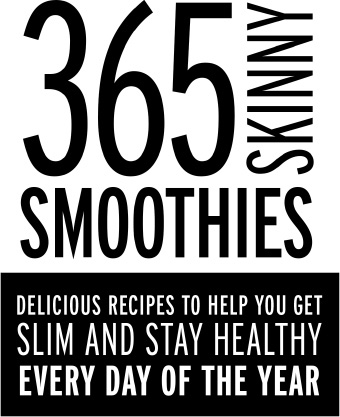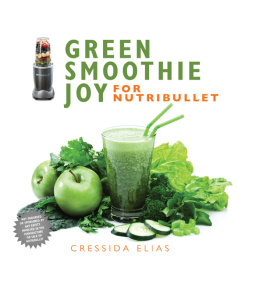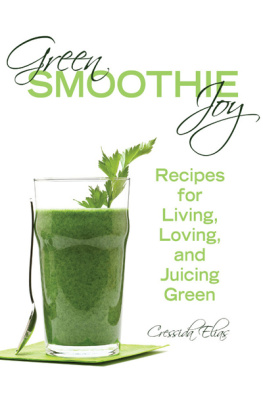 DANIELLA CHACE, MSc, CN CONTENTS : RECIPES FOR A SKINNY LIFE Nutrition Secrets for Losing Weight with Smoothies The Essential Weight-Loss Smoothie Ingredients The Smoothie Makers Kitchen January Smoothies February Smoothies March Smoothies April Smoothies May Smoothies June Smoothies July Smoothies August Smoothies September Smoothies October Smoothies November Smoothies December Smoothies INTRODUCTION Recipes for a Skinny Life The smoothie recipes in 365 Skinny Smoothies are nutritious elixirs designed to promote weight loss and increase energy. As a nutritionist, I know that smoothies are a dream come true because they can be a vehicle for macronutrients such as protein, essential fatty acids (EFAs) and complex carbohydrates, as well as micronutrients such as vitamins, minerals and phytonutrients. I started making smoothies 20 years ago when I worked with cancer patients who needed concentrated amounts of protein and nutrients to support their immune systems throughout their healing process. I found that nutrient-dense foods and supplements could be added to delicious concoctions to create powerful healing drinks that taste delicious. I use peer-reviewed studies and carefully choose the research I use when creating recipes for specific health outcomes. Therefore, while creating the weight-loss smoothies in 365 Skinny Smoothies, I culled through hundreds of food-nutrient studies to find the most effective foods for increasing muscle and decreasing body fat.
DANIELLA CHACE, MSc, CN CONTENTS : RECIPES FOR A SKINNY LIFE Nutrition Secrets for Losing Weight with Smoothies The Essential Weight-Loss Smoothie Ingredients The Smoothie Makers Kitchen January Smoothies February Smoothies March Smoothies April Smoothies May Smoothies June Smoothies July Smoothies August Smoothies September Smoothies October Smoothies November Smoothies December Smoothies INTRODUCTION Recipes for a Skinny Life The smoothie recipes in 365 Skinny Smoothies are nutritious elixirs designed to promote weight loss and increase energy. As a nutritionist, I know that smoothies are a dream come true because they can be a vehicle for macronutrients such as protein, essential fatty acids (EFAs) and complex carbohydrates, as well as micronutrients such as vitamins, minerals and phytonutrients. I started making smoothies 20 years ago when I worked with cancer patients who needed concentrated amounts of protein and nutrients to support their immune systems throughout their healing process. I found that nutrient-dense foods and supplements could be added to delicious concoctions to create powerful healing drinks that taste delicious. I use peer-reviewed studies and carefully choose the research I use when creating recipes for specific health outcomes. Therefore, while creating the weight-loss smoothies in 365 Skinny Smoothies, I culled through hundreds of food-nutrient studies to find the most effective foods for increasing muscle and decreasing body fat.
The medicinal smoothie recipes in this book will help you lose weight in various ways, such as reducing body fat storage by decreasing insulin stimulation, reducing cellulite by triggering the release of stored water (edema) and increasing enzymes that will help shed body fat. A quick search for weight-loss smoothies online will turn up a plethora of misinformation as well as high-calorie, sugar-laden recipes created by smoothie enthusiasts who may not know much about nutrition. However, the studies referenced here and the nutrition tips are all based on empirical evidence. When you incorporate these smoothies into your daily routine, along with exercise and a healthy diet, these recipes can have a profound and direct effect on your health and your weight.
YOUR KITCHEN AS A LEARNING LAB
By trying out the recipes in this book, you are essentially creating a lab in your kitchen by experimenting with various nutrients that boost weight loss. Each recipe introduces a weight-loss concept, such as adding probiotic supplements and cultured foods; increasing phytochemicals found in greens and berries; increasing spices that reduce inflammation; hydrating with electrolytes; stocking up on frozen berries and dry goods; and adding protein such as hemp, chia or protein supplement powders to your smoothies.
Youll quickly master the basics of smoothie making, and youll soon be ready to start customizing your own smoothies based on your taste preferences and nutrient needs. For example, my favorite morning combination is coconut water, banana, nonfat Greek yogurt, wild blueberries, protein powder and probiotics powder (see the January 30 recipe, Chaces Morning Boost in Chapter 4). However, everyones tastes and needs vary, so you may prefer, for instance, cherry juice for the base and you may need more vitamin C. Thus, you might choose to add citrus and greens to your breakfast smoothie recipe.
HOW TO USE THIS BOOK
The recipe chapters are organized by perishable ingredientsthis means that each months recipes are grouped together according to their staple ingredient in order to ease your shopping burden. This allows you to use up the fresh foods that youve purchased so there is less waste, and you wont have to fill your refrigerator with too many new products all at once.
If you follow the book from beginning to end, you will be buying the minimal amount of new foods each week. In addition, seasonal ingredients are the focus for each month, which makes it easier to find ingredients that arent available year-round. Keep in mind that you can always alter a recipe if you cant find a particular ingredient, so its not necessary for you to hunt down anything unusual or hard to find in your area. Ive provided ideas for alternates to use when youre out of a particular ingredient in the ingredient list provided in . Rest assured that the recipes in this book are all low calorie. The ones that have fewer than 250 calories are considered to be snackslittle pick-me-ups to drink between meals or as an addition to a light meal.
You can enjoy these smoothies several times throughout the day without racking up the calories. There are a few smoothies that contain more than 250 calories, and these can be used as meal replacements. With each recipe youll find the amount of calories, fat, carbohydrates, fiber and protein for each smoothie. The goal in creating a balanced smoothie is to keep the calories and fat content low (unless the fat is from a healthy source such as avocado) and to have as much fiber and protein as possible. The nutritional content breakdowns are listed per serving. Some of the recipes are just one serving while some are larger and make two servings.
Recipes can be doubled easily or divided in half to meet your needs depending on whether youre making smoothies for one or two people. In the old days we had milkshakes and slushy-type drinks with lots of fat, sugar, calories and food coloring. Now we know that we can make nutritious smoothies that have a comfort food texture and flavor without all of the unhealthy ingredients. To this end, these smoothies are not only full of weight-loss nutrients but also are delicious and rich with satisfying flavor. Each smoothie is composed of a balance of protein and fiber to allow for a slow release of the carbohydrates, which gives your body time to burn the calories as energy rather than storing them as fat in the thighs or abdominal region. The recipes also contain essential fatty acids that increase the enzymes that help us release the body fat we already have so we can burn it for energy as well.
Many of these recipes contain natural fiber from their fruits, vegetables, seeds and nuts; however, adding a half teaspoon of a fiber supplement to each smoothie will further reduce the glycemic load of the smoothie, which means youll get an even longer energy boost. All you really need to get started is a blender, a liquid (which can be as simple as water), fresh or frozen produce (such as a banana) and some protein (nuts, seeds, protein powder). Toss them in your blender or food processor, blend until smooth and drink right away.
A YEAR OF EXPLORING SMOOTHIES
Keep in mind that everyones taste buds are different. Some prefer hot and spicy, some prefer sour, and others prefer sweet and creamy. This book has something for everyone.
My intention is to introduce you to several new flavors and combinations each month so that you can try them until you find your favorites. In the following chapter I have illuminated some fascinating and little-known nutrition secrets. I reveal tips that I share with clients to help them lose weight. As you work your way through the recipes in this book you will be incorporating these strategies and learning from experience which ones work best for you. I hope you enjoy sampling the flavors of life while you energize your body one smoothie at a time! CHAPTER 1 Nutrition Secrets for Losing Weight with Smoothies T his chapter offers somesecrets that can help you get your metabolism burning at peak rate. We each havedifferent and specific nutritional needs.
For example, at any given point intime we may have nutrient deficiencies, or our metabolism may be effected bytoxins or our immune systems may be triggered by food allergens. You can testyour metabolism by experimenting with the following strategies to see what worksfor you. For example, reducing exposure to toxins will help some people shedpounds immediately, while others see more weight loss when they avoid foodstheyre allergic to. Youll know youre impacting your ability to lose weightwhen you start to shed pounds.
Next page














 DANIELLA CHACE, MSc, CN CONTENTS : RECIPES FOR A SKINNY LIFE Nutrition Secrets for Losing Weight with Smoothies The Essential Weight-Loss Smoothie Ingredients The Smoothie Makers Kitchen January Smoothies February Smoothies March Smoothies April Smoothies May Smoothies June Smoothies July Smoothies August Smoothies September Smoothies October Smoothies November Smoothies December Smoothies INTRODUCTION Recipes for a Skinny Life The smoothie recipes in 365 Skinny Smoothies are nutritious elixirs designed to promote weight loss and increase energy. As a nutritionist, I know that smoothies are a dream come true because they can be a vehicle for macronutrients such as protein, essential fatty acids (EFAs) and complex carbohydrates, as well as micronutrients such as vitamins, minerals and phytonutrients. I started making smoothies 20 years ago when I worked with cancer patients who needed concentrated amounts of protein and nutrients to support their immune systems throughout their healing process. I found that nutrient-dense foods and supplements could be added to delicious concoctions to create powerful healing drinks that taste delicious. I use peer-reviewed studies and carefully choose the research I use when creating recipes for specific health outcomes. Therefore, while creating the weight-loss smoothies in 365 Skinny Smoothies, I culled through hundreds of food-nutrient studies to find the most effective foods for increasing muscle and decreasing body fat.
DANIELLA CHACE, MSc, CN CONTENTS : RECIPES FOR A SKINNY LIFE Nutrition Secrets for Losing Weight with Smoothies The Essential Weight-Loss Smoothie Ingredients The Smoothie Makers Kitchen January Smoothies February Smoothies March Smoothies April Smoothies May Smoothies June Smoothies July Smoothies August Smoothies September Smoothies October Smoothies November Smoothies December Smoothies INTRODUCTION Recipes for a Skinny Life The smoothie recipes in 365 Skinny Smoothies are nutritious elixirs designed to promote weight loss and increase energy. As a nutritionist, I know that smoothies are a dream come true because they can be a vehicle for macronutrients such as protein, essential fatty acids (EFAs) and complex carbohydrates, as well as micronutrients such as vitamins, minerals and phytonutrients. I started making smoothies 20 years ago when I worked with cancer patients who needed concentrated amounts of protein and nutrients to support their immune systems throughout their healing process. I found that nutrient-dense foods and supplements could be added to delicious concoctions to create powerful healing drinks that taste delicious. I use peer-reviewed studies and carefully choose the research I use when creating recipes for specific health outcomes. Therefore, while creating the weight-loss smoothies in 365 Skinny Smoothies, I culled through hundreds of food-nutrient studies to find the most effective foods for increasing muscle and decreasing body fat.